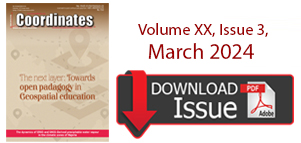Articles in the Policy Category

On August 21, 2008 the cabinet approved the proposal of the Department of Land Resources (DoLR), Ministry of Rural Development to merge two existing centrally sponsored schemes and replace them with the modifi ed scheme of National Land Records Modernization Program (NLRMP). The two schemes being merged are the Strengthening of Revenue Administration & Updating of Land Records (SRA&ULR) and Computerization of Land Records (CLR).

Land Information Management System is defi ned as the combination of human and technical resources, together with a set of organizing procedures that produces information on land in support of a broad range of managerial requirements. Data are raw collection of facts. Data relating to land may be acquired and held in alphanumeric form (for example books), or graphically (for example, as maps or aerial photographs), or digitally…
PhotograPhy happens to be my current favourite hobby. Recently I developed interest in geocoding my photographs. By geocoding photographs you can associate a geographical location with the photograph. This involves putting the latitude, longitude and altitude in the photographs EXIF tags. Exchangeable image file format (Exif) is a specification for the image file format used by digital cameras. This is trivial if you use a GPS receiver. Last year, I had succeeded in making necessary interface to my Nikon D200 camera with a GPS receiver.

Satellite remote sensing has been used to varying degrees around the
world for over three decades. Over that time the degree to which the technology has been applied has varied greatly from country to country – from being broadly embraced to being used hardly at all. Simply stated, where remotely sensed data and related geospatial data are used in a limited fashion the full economic and social value of the data for resource evaluation, sustainable resource management, and environmental protection is not realized. This paper examines the key factors that appear to be associated with varying use of the data and consequent derivation of benefits. At one time it was thought that this use was related to the economic situation within a country or the quality of training and education. While these factors are of course important, this work isolates other factors as being equally if not more important. These factors include data policy, approaches to commercialization, the level of applied research and links to “real” users. This paper explores the importance of these other factors with special reference to data policy in Thailand and Canada.

This note is about two developments in the mapping world that should be of interest to professionals in the geospatial industry. One took place in the United States where a group of surveying professionals have asked the courts for a ruling on who may be able to tender for public contracts to draw ‘maps’. This development should raise the concern of most geospatial professionals. The second took place at the opposite end of the world in Australia where the Copyright Agency representing surveyors has sought a ruling on the ownership of intellectual property rights of surveyor’s maps. While these two cases are interesting such developments are indicative both of the maturing of the geographic information (GI) profession and the willingness of professionals to assert their ‘rights’.

The tools of GI Science deal with geospatial information in which spatial relationships are the fundamental data. Fundamental data is that which relates to geolocation or spatial data that will permit the mapping of any object in terrestrial space. But, GI Science may also handle a diverse range of personal information from the truly ‘personal’ ones through to those of a more general nature – age, gender, height, home address, social security number…

Such development will help the LBS industry. There are three aspects of LBS in my mind. One is essential location finding, which is security related to our parents and children. Like I am worried about my child so I would always like to know where my child is. And the mobile industry has manylive solutions for that. The second is corporate and business related location based services. The third is mobile marketing location based services which will give the real lease of activity to this industry. There you will be able to hunt for things which you need and you get special offers on that. So you’re attracted to hunt for them. So I think LBS marketing will be the biggest thing.

Government of India, Ministry of Finance, Department of Revenue, Central Board of Excise & Customs
Sub: Clarification in respect of classification of higher technology featured mobile / cellular handset or telephones – regarding.
Board has received certain representations from the trade and industry regarding classification of higher technology featured mobile / cellular handsets or telephones, which contain GPS features apart from other functions like music, camera, voice recording, e-mail, internet and related editing features. Field formations have also requested to issue a clarification in the matter of classification of a hybrid product containing PDA, mobile phone with camera and GPS, which are being imported presently.
I am an avid outdoor enthusiast and as such got a very simple GPS handset as a gift from a friend visiting me from abroad. This GPS can simply tell me my location in terms of latitude and longitude anywhere on earth. It can also help me trace back my route if I am lost in say a jungle or desert etc. The device is intended for use outdoors just for fun.
A few friends told me that apparently I need a license to use this device in India. I did some internet based research to find out the truth behind the matter and came across your magazine where you had printed an interview of Mr P K Garg, Wireless Adviser to Government of India, Wireless Planning and Coordination (WPC) Wing, Ministry of Communications and IT, Government of India. Although I was surprised to read that yes indeed I needed a license to operate the device in India, as confirmed by Mr Garg, being a law abiding citizen I decided I must acquire the license before operating it or at least apply for it. This started off a very frustrating process for me of trying to crack the bureaucracy which I am relating below in the hope that it will be read by someone who is authoritative enough to help me out.

The U.S. National Space Policy (NSP) was authorised by President Bush on August 31, 2006. This NSP establishes an overarching national policy that governs the conduct of U.S. space activities and supersedes the 1996 NSP.
The unclassified ten-page summary of the NSP consists of 13 self-contained sections including the principles, goals, guidelines (both general and specific to national security space, civil space and commercial space), international space cooperation, space nuclear power, radio frequency spectrum, orbital debris, effective export policies and space-related security classification.







 (5.00 out of 5)
(5.00 out of 5)